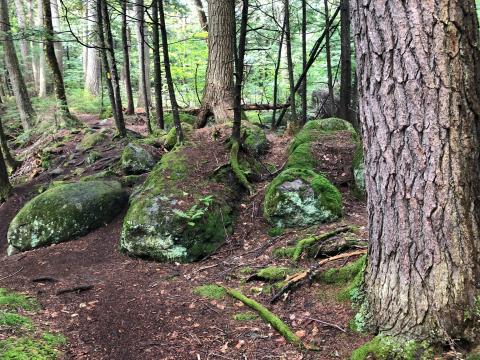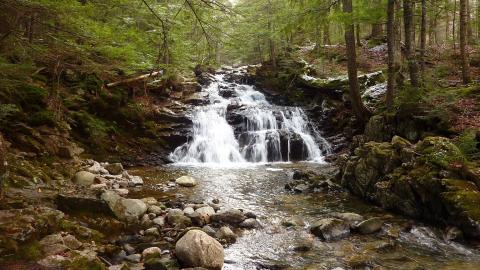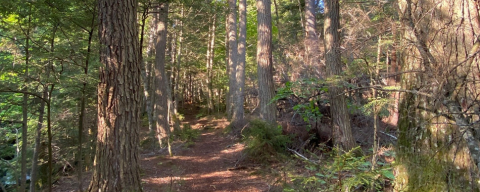Explore the Valley of the Green Giants in Randolph, NH
One of the finest examples of an ancient forest in New Hampshire is along Snyder Brook in Randolph, NH. I call this alluring place the Valley of the Green Giants. Here in the White Mountain National Forest are gorgeous waterfalls and towering trees measuring 10 feet in circumference and over 90 feet tall.
The big trees include some state and county champion hemlock, white pine, and red spruce. Large specimens of sugar maple, yellow birch, and beech are also present. This forest, a Hemlock-Spruce-Northern Hardwood type, was never logged and is an easy hike from the Appalachia Trailhead on US Route 2 in Randolph.
Old-growth forests in New Hampshire are rare. Snyder Brook features the four main characteristics of an old-growth forest:

Snyder Brook Old Growth
1. Big old trees that have been around for hundreds of years. The oldest tree measured is 370 years old.
2. Large standing dead trees that we call snags.
3. Large fallen trees on the ground that we call coarse woody debris.
4. A multi-layered canopy of trees of distinct layers, species, heights, and canopy gaps.
The story of why we have such a spectacular forest so easily accessible is interesting. The 36-acre tract was also one of the first forests preserved because of its scenic beauty. The story began when the railroad reached Randolph in the 1890s, connecting a formerly isolated community with the rest of New England. Soon hotels, including the Ravine House that hikers favored, sprang up. The same railroad that brought visitors in during the summer also brought logging to the slopes of the Northern Presidential Range.
In 1895, Laban Watson, proprietor of the Ravine House, approached the members of the Appalachian Mountain Club (AMC), describing his plan to log the lower slope of Mount Adams and Madison. The members of the AMC, founded in 1876, decided that they wanted to preserve the area around Snyder Brook because of its towering trees and beautiful waterfalls. The AMC and its members were keenly aware of the large-scale logging in the White Mountains. They were also undoubtedly aware of the 1892 acquisition of over a million acres of forest to create the Adirondack Park in New York as "forever wild."
The Trustees of Real Estate of the Appalachian Mountain Club agreed to acquire a 600-foot wide strip extending a half mile up along Snyder Brook from Laban Watson on May 29, 1895. The size of the tract totaled roughly 36 acres. The purchase price was $400, which, adjusted for inflation after 127 years, would be worth $14,110 today. A great bargain then and now.
The AMC donated the Snyder Brook reservation to the White Mountain National Forest in 1937, during the Great Depression. The reasoning was that the US Forest Service would be in a better position to protect the land. There was no formal level of protection for Snyder Brook until 1961, when Snyder Brook became a designated Scenic Area. This special designation and level of protection occurred on the 50th Anniversary of the Weeks Act. The Weeks Act of 1911 was the federal legislation that authorized the creation of the White Mountain National Forest and many other national forests in the Eastern United States.
Today the Snyder Brook Scenic Area is a beautiful short hike or winter snowshoe to see towering trees, many of which are over 300 years old. Several gorgeous waterfalls along the way add to the allure of what I call the Valley of the Green Giants. Don't be surprised at the lack of hikers on these two paths; most hikers will be using the nearby Valley Way Trail to reach the higher peaks.

The Brookbank and Fallsway Paths maintained by the Randolph Mountain Club provide the best access to the old-growth trees and waterfalls. These two paths are a five-minute walk from the starting point at the Appalachia Trailhead along US Route 2 in Randolph, NH. The Trailhead is located on US Route 2, 5 miles west of the intersection of US 2 and NH Route 16.
From the Appalachia Trailhead, walk east a few hundred yards along the Presidential Rail Trail to the start of the Fallsway Trail. Cross under a powerline and enter the forest.
Soon you will realize that you are standing amongst giants. This forest is what much of the original forest looked like before the extensive logging over a century ago. Continue uphill past Gordon and Salroc Falls until you come to Tama Falls.
You can return the same way along the Fallsway Path or during low water, cross over Snyder Brook and take the Brookbank Path down to the rail trail. Yellow blazes mark both paths. The round-trip hike or snowshoe is 1.6 miles with a 400-foot elevation change.
Suggested Reading:
- Finding Old-Growth Forests in New Hampshire, exploring the unique characteristics of old growth forests.
- Magnificent Dry River Old-Growth Forest is a Hidden Gem in Crawford Notch State Park
- Fun Facts about Yellow Birch in New Hampshire
- Saving the Old-Growth Forests of Mad River Notch A Century Ago – And Visiting them Today
- Towering Trees in Tamworth: Towering Trees and Old-Growth Forest at Tamworth’s Big Pines Natural Area
- For a list of other old-growth forests, see Top Old-Growth Forests to Visit in New Hampshire
- Find and nominate old-growth forests at Old Growth Forest Network
David’s professional background was with the U.S. Forest Service, where he worked for 33 years until retirement in various positions and locations across the country as a Forester, Silviculturist, and Forest Fire Management Officer. David worked for 20 years on the White Mountain National Forest. Since his retirement, he works for RAVEN Interpretive Programs as a Naturalist. David has also worked as an expedition ship naturalist in Alaska and Iceland. Among his many roles David is a UNH Extension Volunteer for NH Big Tree, Coverts, and Speaking for Wildlife programs.
David is a co-author of Forests for the People: The Story of the Eastern National Forests. He served as technical advisor for the documentary film The People's Forest, and has written numerous magazine and journal articles on forest history. He recently completed a goal to visit all 175 National Forests and National Grasslands located in 41 different states.

